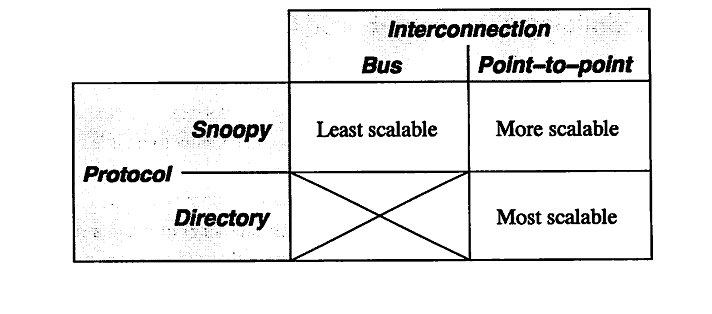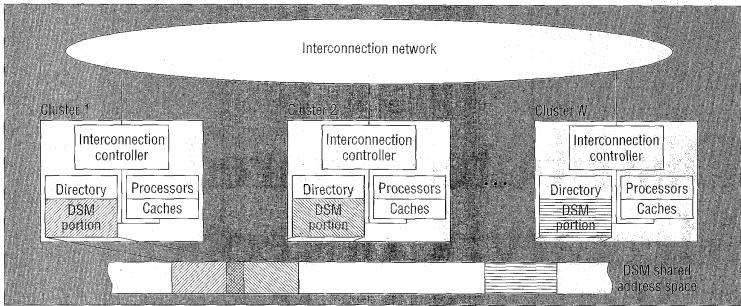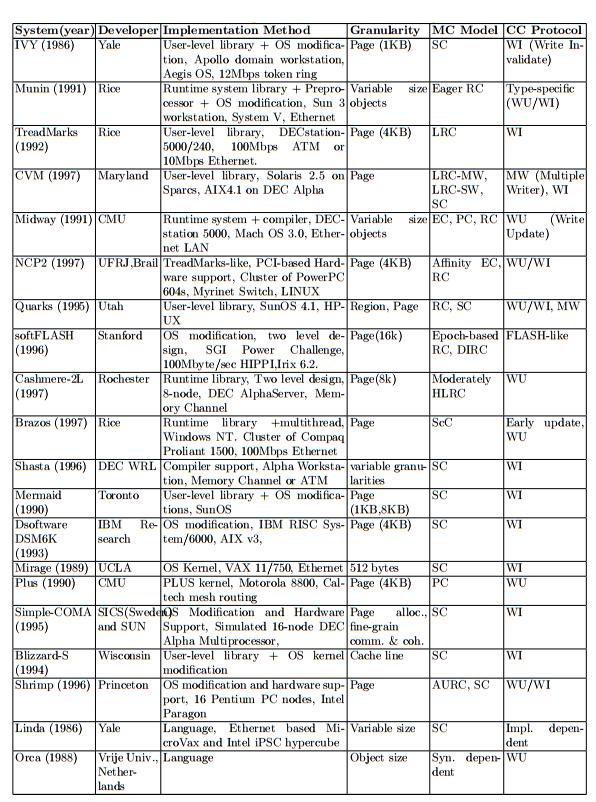ECE506 CSC/ECE 506 Spring 2013/11a ad
Introduction
When dealing with a relatively small number of processors (8-16), according to Solihin 320, using a bus based shared memory structure is fine. Unfortunately, when you need to provide a shared memory structure for processors much greater than that, you will need a different set of organization. This new organization is needed due to the physical limitations of the bus. There are two ways you can create such a system. These include Distributed Shared Memory (DSM) or Non-Uniform Memory Access (NUMA). The benefits of having a DSM and NUMA is that we can now scale to a larger amount of processors. The disadvantage is that scaling in such a way may not be the most cost-effective solution, Solihin 320. For the remainder of this section, we will be discussing the performance of DSM's.
According to Solihin 320, there are two aspects that restrict the scalability of bus-based multiprocessors. These include the physical limitations of interconnections and the limitations of the protocol. To explain in detail, on a bus-based system, adding a processor will not affect any other physical restrictions on the system. Unfortunately, when adding a new processor, you will be reducing the speed of the bus. Second, the protocol needed to keep coherence does not scale well. As you increase the number of processors to the system, the amount of traffic also increases. This means that you might run the risk of overwhelming the bandwith. According to Solihin, there are a few ways that we can mitigate this problem. The following is from 321 of the Solihin textbook.

From the table, we can see that there is three ways to scale a multiprocessor system. The first being a single bus system. This is the least scalable due to the limitations of the bus wire itself. As you add processors you will decrease the bus speed due to having to increase the wire length. Also, you run into an issue of overwhelming the bus due to the amount of traffic. The second way is to use a point-to-point bus system. This allows for the speed of the bus to remain relatively fast, but since the traffic will also scale with the number of processors, there will be a limitation due to overwhelming the bus system with traffic. Lastly, the most scalable system to date is using a directory system. This allows for the bus to remain fast due to the short wires, and the bus traffic to remain low since the directory holds information on cache locations.
Protic <ref name="protic">Protic, J.; Tomasevic, M.; Milutinovic, V.; , "Distributed shared memory: concepts and systems," Parallel & Distributed Technology: Systems & Applications, IEEE , vol.4, no.2, pp.63-71, Summer 1996 doi: 10.1109/88.494605 paper</ref> defines a DSM to "consists of multiple independent processing nodes with local memory modules, connected by a general interconnection network." What this means is that rather than having these processors connected on a single bus line, there is a network of bus lines. The new issues that arise from such a method involves how to communicate with another node. This is usually solved using a message passing model that is effective depending on the topology that is used. According to Protic, "... compared to shared-memory systems, hardware problems are easier and software problems more complex in distributed-memory systems." What we can walk away with is that even though you have made the hardware limitation less of a factor, the software problem is now more complex in nature. A good picture of what a DSM is, is shown below.

doi: 10.1109/88.494605
paper</ref>
According to Nitzberg <ref name="nitzberg">Nitzberg, B.; Lo, V.; , "Distributed shared memory: a survey of issues and algorithms," Computer , vol.24, no.8, pp.52-60, Aug. 1991
doi: 10.1109/2.84877
paper</ref> DSM has been researched since the 1980's. There are many reasons why DSM has been an area of research focus. Uniprocessor bus-based systems suffer from a hardware and software limitation that can be mitigated using a DSM. But, this has only become an issue as we start having more and faster processors that we want to add to the system. There are three approaches that have been used to implement a DSM system. These include hardware, operating system, and compiler implementations.
According to Shi <ref name="shi">Shi, Weisong. Performance Optimization of Software Distributed Shared Memory Systems. Beijing: Higher Education, 2004. Print. paper</ref>, "The main difficulty in building a software DSM system is solving the memory coherence problem, namely, the problem of how to make a newly written value to be visible to demanding processors on time." Regarding this issue, the two major points are the memory consistency model and cache coherence protocols. The best description is given by Shi<ref name="shi"></ref>, "...memory consistency model determines when the modified data should be visible to other processors and cache coherence protocol determines what values should be visible to other processors." From earlier, we can see that on a shared bus line multiprocessor system, this is already a complex problem. When adding a layer of abstraction, this can become a very large problem. For these two complex problems, there are two spectrum of solutions. One being hardware support, the second being software support.
Software Support
In 1986, the first software supported DSM was created. Since then, it has been well over 20 years and there have been great improvement upon the first initial system. First, it is usually the case that the software support will find some way to relax the memory consistency model. This is due to the fact that memory passing on a DSM is much more expensive than message passing on a single bus system. Over the last 20 years, over 20 different memory consistency models have been proposed <ref name="shi"></ref>. Second, cache coherence must be addressed. Having multiple cache copies means that when one copy is updated the other cache copies should be affected in some way such that the old values are not used. Traditionally there are two techniques, one being snoopy protocol and the second being directory based protocol. According to Shi <ref name="shi"></ref>, snoopy protocol is less used due the fact that it requires hardware support. Lastly, according to Shi <ref name="shi"></ref> the major problem is the interface. For a DSM system to be competitive, it has to be able to work for many customers. Below is a listing of some representative software DSM implementations.

Hardware Support
Although a lot of research has been towards software support for DSM, there has been some research in adding some hardware support. Unfortunately, according to Shi <ref name="shi"></ref> there is a rejection of hardware support from large corporations. What will occur when using hardware support is a issue of compatibility. Fortunately, recent adoptions of certain hardware standards will allow for some hardware support on the mass level.